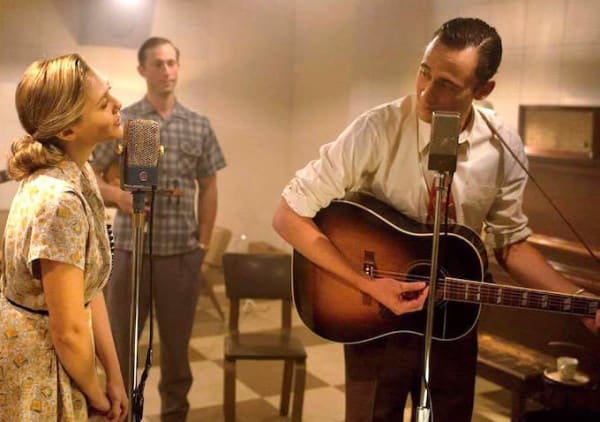The fifth annual Sun Valley Film Festival runs March 2-March 6 in Ketchum, Idaho, featuring over 60 narrative films and documentaries, as well as special guests Oliver Stone, Mark Duplass, Bruce Dern and Amy Smart, and musical guests The Joy Formidable and Thunderpussy. Films are shown at local venues including the Sun Valley Opera House, Magic Lantern Cinemas, and NexStage Theatre in a celebration of film and storytelling.
I Saw the Light
Written and directed by Marc Abraham
USA, 2016
I Saw the Light, starring Tom Hiddleston as musical legend Hank Williams Sr., shines a little, but its light is brief and slight, and unlikely to carve an enduring spot in the film pantheon. Biopics so often track the exact same story trajectory, and yet it seems nearly impossible to produce a genuinely good one. Music biopics often begin with their protagonist in the gutter from whence he (or she, but almost always it’s a he) came, track the star’s rise to fame, the inevitable betrayal/jettisoning of early music partners and friends, the romance and marriage, the transition into womanizing and addiction, scandals and fall from success followed by sobriety and rise again, loss of the wife to divorce/separation, and the inevitable fall back into addiction and an early death. While the difficulties of juggling the sheer length of a star’s life, and all the people and events in it, and knowing what to select, are apparent, it’s not impossible to do so successfully.
A good music biopic ably highlights the music as a central tenet, while setting up complex relationships with a handful – no more than a handful – of key players from the musician’s life, and doesn’t strive to track the star from birth to death, but chooses a key time period – say about five years – to hone in on. Walk the Line, easily one of the most successful biopics of the past few decades, checks most of these boxes, and while not a music biopic, part of Selma‘s success was its refusal to cover King’s life as a whole, instead focusing on that key period in Selma.
I Saw the Light is bold enough to ditch one trope of the genre, but clings onto all the rest. Jettisoning entirely Hank Williams’ childhood and early rise, it picks up on the eve of his marriage to first wife Audrey May (Elizabeth Olsen), after he already has a successful live-performance radio show. This gives the first third of the film a great energy, as Williams’ star rapidly rises, while the story balances this by devoting great detail to his volatile relationship with his complex wife. Olsen’s Audrey May is the only character in the film portrayed as having a strong connection to Williams, and Olsen delivers such a fiery, convincing performance that she essentially outshines Hiddleston’s Hank. Driven and stubborn to the point of self-delusion, Audrey May plans to have a musical career alongside her famous husband, and her failed attempts drive her to fury – yet her deep, genuine love for her husband keeps her in the marriage. The two make it through various conflicts, including Williams’ womanizing and alcoholism.
As soon as Olsen, and that relationship, fade from the story, however, the film begins to falter, in large part because it has built no other interesting relationships. There are hints of a fascinating, mentor/father figure relationship with Fred Rose, founder of the music company that signed Hank, but that relationship is glossed over, presented as trivia. Instead, Rose (played with great warmth and humanity by Bradley Whitford, one of many stellar castings in this film), appears in various interview-style clips interspersed throughout the film, explaining events and facts of Hank’s life.
These clips are necessary and, shockingly, almost underused, because one of the film’s problems is that it seems to assume knowledge of Williams’ life – his health issues in particular are vague and poorly explained. At one point in the film, there’s reference to his recurring pain – a pain that has appeared exactly once onscreen before. His band members are recognizable only by their faces and seem entirely exchangeable, and his career developments and changes are rushed and occasionally confusing. In a genre too often plagued with exposition, I Saw the Light oddly offers too little.
The film does shine in two realms however: performance, and music. Olsen’s Audrey May lives and breathes her character, but nearly as impressive is how effortlessly and well Hiddleston takes on the mantle of Williams’ distinctive voice, accent, and performance style. The performances throughout the film were largely performed live by the band, and beautiful cinematography and sound quality turns these into magical, foot-tapping, blues-embracing sequences of sonic and visual joy, standing out even for the genre. It’s in these, the scenes that require the most of him, that Hiddleston comes alive, a potency pouring off the screen. Yet on the whole, the film gives him little to do, and it’s astounding what a relatively opaque figure Williams remains by the end of the film.
A rare interlude, somewhere close to the end of the film, in which Hank has a real, one-on-one conversation with someone, showcases what the film have been. A Tribune reporter sits down with him for an interview, sincerely determined to find out something of what drives Hank Williams, the legend. Hank, after disparaging and insulting him and his industry, leans forward. Absolute, controlled conviction snaps through him, as he drawls with angry passion, “Folk music, hillbilly, it’s sincere. There ain’t nothin’ phony about it.”
That folk music magic shines through in the film’s enthralling performance scenes – moments of hope, grief, loss and beauty, that tell the truth of the man and his story. This film will, unlike its subject, not be long-remembered or loved, but the acting by major players does levitate a middling biopic into very watchable territory.

